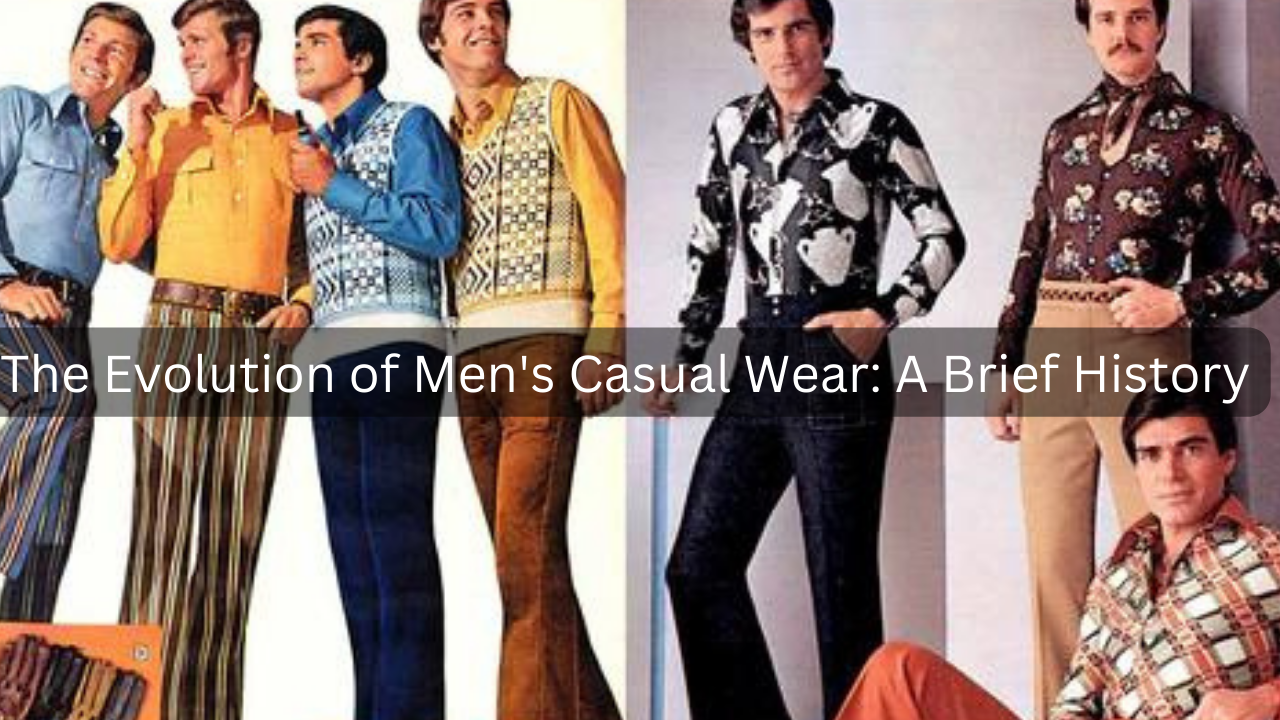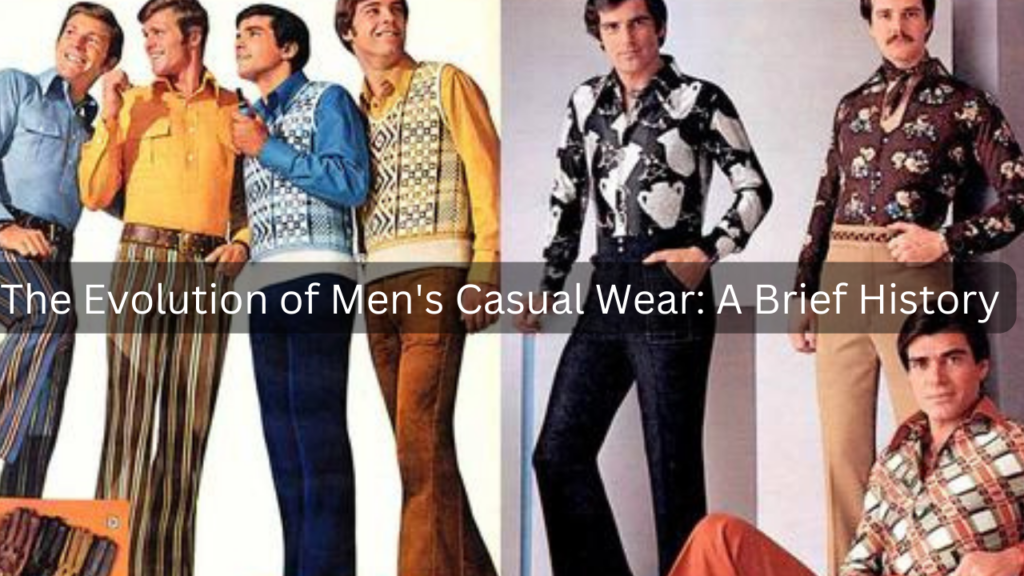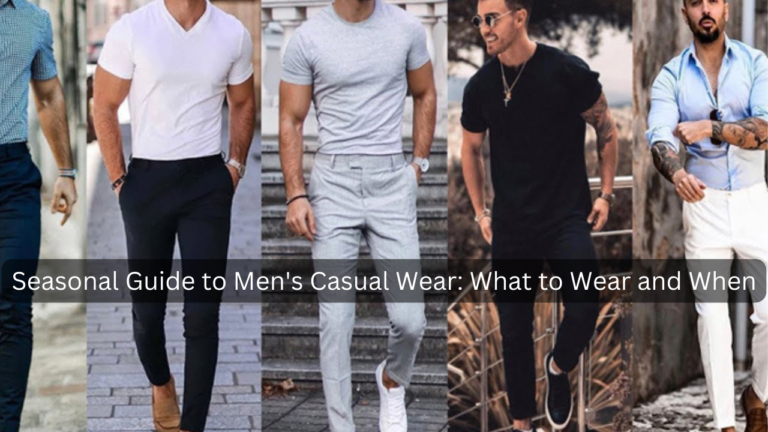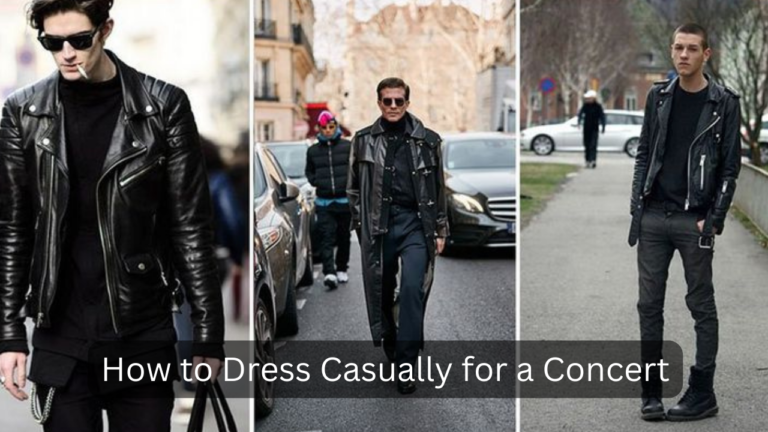

Table of Contents
Introduction
Casual wear has evolved significantly throughout history, reflecting broader societal changes and cultural shifts. Defined as attire that prioritizes comfort and relaxation over formality, casual wear encompasses a wide range of styles, from everyday clothing to weekend attire and sportswear. In the realm of men’s fashion, casual wear plays a pivotal role, offering a versatile means of self-expression that balances comfort with personal style.
Definition of casual wear
The importance of casual wear extends beyond mere comfort; it serves as a reflection of cultural attitudes towards leisure, work-life balance, and individuality. As societal norms have shifted, so too has the definition and acceptance of what constitutes appropriate casual attire. Understanding the evolution of men’s casual wear not only provides insight into fashion trends but also offers a window into the evolving perceptions of masculinity, professionalism, and personal identity.
Importance of casual wear in men’s fashion
In exploring the evolution of men‘s casual wear, we uncover a narrative that spans centuries, shaped by historical events, technological advancements, and shifting attitudes towards lifestyle and leisure. From its humble origins to its contemporary expressions, casual wear continues to evolve, reflecting the dynamic interplay between fashion, culture, and personal expression.
Early Origins of Casual Wear
Historical Context (19th and Early 20th Centuries)
The roots of casual wear can be traced back to the 19th century, a period marked by significant industrialization and societal changes. As urbanization accelerated and economies diversified, traditional dress codes began to adapt to new modes of living and leisure.
During the 19th century, the Industrial Revolution spurred the growth of cities and factories, leading to a clearer distinction between work attire and leisurewear. Men’s clothing, which had been predominantly formal and dictated by social status, gradually began to incorporate more relaxed elements suited for leisure activities.
Influence of Leisure Activities on Clothing (Sports, Vacations)
Leisure activities played a pivotal role in shaping early casual wear. Sports such as tennis, golf, and cricket gained popularity among the affluent classes, necessitating specialized attire that was both functional and comfortable. The polo shirt, for instance, emerged from the sport of polo in the late 19th century, characterized by its breathable fabric and collar design.
Similarly, vacations and seaside retreats became fashionable among the elite during the late 19th and early 20th centuries. This trend influenced the adoption of casual attire suitable for relaxed settings, such as lightweight trousers, casual shirts, and knitwear. The concept of resort wear, designed specifically for warm-weather destinations, further contributed to the evolution of men’s casual clothing.
As leisure activities became more accessible and culturally significant, the demand for comfortable and practical clothing grew. This shift marked a departure from the rigid formality of earlier centuries, paving the way for a more relaxed approach to men’s fashion that emphasized comfort without sacrificing style.
In essence, the early origins of men’s casual wear reflect a period of transition and adaptation, where clothing began to reflect not just social status but also individual preferences and lifestyle choices influenced by leisure activities and changing societal norms.
Casual Wear in the Mid-20th Century
Post-World War II Changes
The mid-20th century witnessed a profound transformation in men’s casual wear, largely influenced by the aftermath of World War II. As economies recovered and societies underwent cultural shifts, the concept of casual attire became more ingrained in everyday fashion.
Rise of Sportswear and Leisurewear
Post-World War II, sportswear and leisurewear emerged as dominant influences on men’s casual fashion. The GI Bill in the United States, for example, provided returning soldiers with access to higher education and leisure activities, fostering a culture of recreation and informal dressing.
Sportswear, previously reserved for athletic pursuits, became increasingly popular for everyday wear. This period saw the widespread adoption of items like polo shirts, bomber jackets, and chinos, originally designed for comfort and functionality in sports and outdoor activities. These garments were characterized by their relaxed fit, durable fabrics, and casual aesthetic, reflecting a shift towards more comfortable and practical clothing choices.
Leisurewear also gained prominence during this era, driven by the rise of leisure activities such as beach day vacations, weekend getaways, and suburban living. Hawaiian shirts, Bermuda shorts, and casual knitwear became synonymous with relaxation and leisurely pursuits, body shapes carefree attitude towards dressing outside of formal settings.
The mid-20th century thus marked a pivotal moment in the evolution of men’s casual wear, as post-war prosperity and changing social attitudes towards work-life balance and leisure influenced fashion choices. The integration of sportswear and leisurewear into everyday wardrobes laid the foundation for a more relaxed and versatile approach to men’s clothing, setting the stage for further innovations in casual fashion in the decades to come.
The 1960s and 1970s: Casual Revolution
Counterculture Impact (Hippies, Youth Movements)
The 1960s and 1970s witnessed a seismic shift in men’s perfect casual wear, largely driven by the influence of counterculture movements such as the hippie movement and youth activism. Rejecting the conformity and conservative values of the previous decade, young people sought new forms of self-expression through fashion.
Hippies, in particular, embraced a bohemian lifestyle characterized by free love, anti-establishment sentiments, and a rejection of materialism. Their clothing reflected these ideals, with flowing garments, ethnic prints, and natural fibers becoming popular choices. This cultural movement introduced unconventional styles into mainstream fashion, influencing men’s casual wear for fall with its emphasis on individuality and nonconformity.
Youth movements of the era also played a significant role in reshaping casual fashion. Activism and social change became intertwined with fashion statements, as young men adopted casual attire as a form of rebellion against societal norms and political injustices. T-shirts with slogans, tie-dye shirts, and worn-in classic jeans became symbols of protest and solidarity among youth.
Jeans and Denim as a Symbol of Rebellion and Casual Comfort
During the 1960s and 1970s, jeans and denim emerged as iconic symbols of rebellion and casual comfort in men’s fashion. Originally worn by laborers and miners for their durability, denim jeans were adopted by the counterculture as a statement against the polished and formal clothing associated with previous generations.
The rugged texture and relaxed fit of jeans resonated with the ethos of casual wear, offering a versatile option for everyday use. Brands like Levi Strauss & Co. capitalized on this trend, introducing jeans in various washes and styles that catered to different tastes and subcultures.
Denim became more than just a fabric; it became a canvas for personal expression and cultural identity. Distressed jeans, patched denim, and bell-bottoms were embraced by both countercultural figures and mainstream fashion enthusiasts alike, solidifying denim’s status as a cornerstone of casual wear.
1980s and 1990s: Casualization of Workwear
Business Casual Emerges
The rise of tech culture in the 1980s and 1990s played a pivotal role in shaping casual workwear norms. Silicon Valley, in particular, became synonymous with a laid-back approach to dressing, reflecting the informal and innovative ethos of tech companies. Tech entrepreneurs and employees often eschewed traditional business attire in favor of casual clothing that prioritized practicality and ease of movement.
The influence of tech culture extended beyond Silicon Valley, permeating global business practices and influencing mainstream fashion trends. Casual staples such as polo shirts, khaki trousers, and casual footwear became acceptable choices in professional environments where creativity and productivity were valued as much as formal appearance.
Overall, the 1980s and 1990s witnessed the casualization of workwear, driven by the emergence of business casual attire and the influence of tech culture on dress codes. This shift marked a departure from rigid sartorial traditions towards a more relaxed and inclusive approach to professional attire, reflecting broader societal changes and the evolving expectations of modern workplaces.
2000s to Present: Diverse Influences and Globalization
Streetwear and Urban Influences
The 2000s to the present day have witnessed a dynamic evolution in men’s casual wear, characterized by the rise of streetwear and urban influences. Streetwear emerged from inner-city youth cultures, drawing inspiration from hip-hop, skateboarding, and graffiti art. What began as a niche subculture has evolved into a global phenomenon, influencing mainstream fashion with its bold graphics, oversized silhouettes, and emphasis on comfort and authenticity.
Key elements of streetwear include hoodies, graphic t-shirts, sneakers, and accessories like caps and back packing. Brands such as Supreme, Off-White, and Nike’s Jordan Brand have become synonymous with streetwear, collaborating with artists, musicians, and designers to create limited-edition collections that blur the lines between luxury and casual fashion.
Impact of Social Media and Globalization on Casual Fashion Trends
Social media platforms like Instagram, TikTok, and Pinterest have played a pivotal role in shaping contemporary casual fashion trends. Influencers and celebrities showcase their personal style to millions of followers, amplifying trends and creating global demand for specific brands and your looks. This democratization of fashion has empowered individuals to experiment with different styles and express themselves through clothing in unprecedented ways.
Globalization has also contributed to the diversification of men’s casual wear, as cultural influences from around the world merge and inspire new trends. Traditional garments and textiles from diverse cultures find their way into mainstream fashion, contributing to a richer tapestry of perfect casual clothing options. Moreover, advancements in e-commerce and fast fashion have made it easier for consumers to access a wide range of styles and brands from anywhere in the world, further accelerating the spread of fashion trends.
Future Trends in Men’s Casual Wear
Sustainability and Ethical Fashion
The future of Evolution of Men’s Casual Wear for men is increasingly shaped by a commitment to sustainability and ethical fashion practices. As awareness of environmental and social issues grows, consumers and brands alike are prioritizing garments that are produced with minimal impact on the planet and respect for labor rights.
In response to these demands, we can expect to see an increase in the use of eco-friendly materials such as organic cotton, hemp, and recycled fabrics in casual clothing. Sustainable practices, such as water-saving techniques accessorize in denim production and reduced carbon emissions in manufacturing processes, will become standard across the industry.
Furthermore, transparency in supply chains and ethical sourcing of materials will be paramount. Brands will be expected to disclose information about their production methods and demonstrate accountability towards workers and communities involved in their supply chains.
Integration of Technology in Fabric and Design
Technology will continue to play a transformative role in the fabric and design of men’s casual wear. Innovations such as performance fabrics that offer moisture-wicking properties, UV protection, and temperature regulation will become more prevalent. These advancements cater to the growing demand for clothing that not only looks good look but also enhances comfort and functionality in various environments.
Smart textiles embedded with sensors or wearable technology may also gain popularity, providing additional functionalities such as health monitoring, communication, or adaptive temperature control. This integration of technology into clothing blurs the line between fashion and function, appealing to tech-savvy consumers seeking innovative solutions in their everyday attire.
Conclusion
Throughout its evolution, men’s casual wear has reflected and influenced societal changes, cultural movements, and technological advancements. From its humble origins to its current diverse forms, casual wear has transcended mere clothing to become a symbol of personal expression, comfort, and life style tips.
We began by exploring the early origins of casual wear, rooted in the 19th century’s industrialization and the influence of leisure activities such as sports and vacations. The mid-20th century saw a revolution in casual attire, shaped by post-World War II changes and the rise of sportswear and leisurewear, which offered men more relaxed and functional clothing options.
The 1960s and 1970s marked a turning point with the casual revolution driven by counterculture movements like hippies and youth activism, where denim jeans emerged as a symbol of rebellion and casual comfort. The following decades witnessed the casualization of workwear, epitomized by the emergence of business casual attire and influenced by the relaxed dress codes of tech culture.
Moving into the 21st century, men’s casual wear edition has continued to evolve under the influence of diverse global trends. Streetwear and urban influences have reshaped casual fashion with their bold aesthetics and emphasis on self-expression. Meanwhile, the impact of social media and globalization has democratized fashion, allowing for a more inclusive and dynamic exchange of styles and ideas worldwide.
Looking ahead, sustainability and ethical fashion practices are set to define the future of men’s casual wear, alongside innovations in technology that enhance your casual Look comfort and functionality. These advancements reflect a growing awareness of environmental responsibility and a desire for clothing that aligns with ethical values.
In the contemporary fashion landscape, casual wear holds significant importance as more than just attire; it represents individuality, adaptability, and a reflection of changing lifestyles and values. As men continue to navigate diverse social and professional environments, casual wear remains a cornerstone of their wardrobe, offering versatility and comfort without compromising style.
In conclusion, the evolution of men’s casual wear illustrates not only shifts in fashion but also broader cultural narratives. From its origins in leisure and rebellion to its current role in sustainable fashion and technological innovation, casual wear continues to evolve, ensuring its enduring relevance in the dynamic tapestry of contemporary menswear.





